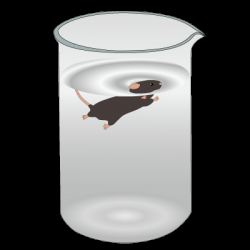We need more information about depression, both to have a better understanding of the causes and exploration of new therapeutics.
Like most scientific endeavors, depression is hard to study in humans or non-human primates. So, like many researchers, neuroscientists study depression in mice. But, how can you tell if a mouse is depressed or not?
Believe it or not, there is a way to do it and its called the forced swim test. Here is how it works.
A single mouse is placed into a transparent cylindrical tank filled with room temperature water. They cannot get out of the tank nor can they touch the bottom. The mice are gently placed into the tank and remain in the water for six minutes. During that time, the mouse is being recorded.
If multiple mice in multiple tanks are tested, the mice should be blocked from seeing each other. Also, a white machine is turned on to block any sounds. After six minutes, the mice are removed, dried and placed back into their cage.
Then, the video is watched and scored. What researchers look carefully at is the mouse's movement while in the water. More specifically, how mobile (undergoing active swimming) the mouse is in the last four minutes of the recording. Mice float pretty well, and they really only need to make small movements to stay balanced and floating. However, some mice really swim because they are consistently trying to get out of the chamber.
It is the amount of movement while in the water that separates a mouse that is not depressed (keeps moving to try to get out) and one that is depressed (gives up and stops swimming.)
Antidepressants increase the amount of time that a mouse spends struggling. Therefore, this behavior test is used to evaluate the effectiveness of new drugs that may prevent depressive-like states.
So, the next time that you take your anti-depressant, you can thank all of those mice that swam just a little bit longer, and put that drug into the category of "potential new drug." Of course, a forced swim test is just the first step in a compound's path to the pharmacy, but, because it is often the first step, it is an important one.

